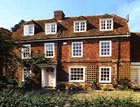Blots on the buyers landscape
It is almost impossible to find a country house that fulfils all your dreams—but sometimes a little compromise can reap dividends


Few country properties tick all the boxes on a buyer?s wish-list, and most successful sales involve a degree of compromise on the part of both vendor and purchaser. In addition to the traditional hazards of pigs, planes, pylons, main roads and motorways, rural-property purchasers must now consider the possibility of suddenly finding themselves living in the lee of a wind farm, a landfill site, a mobile-phone mast, a travellers? encampment, or a reception centre for asylum-seekers. Conversely, relatively minor drawbacks can be useful bargaining tools when it comes to negotiating the price of an otherwise ideal house.
Noise pollution is the greatest single negative factor affecting property values in the countryside. In the Cotswolds, Susie Harrison of Cirencester-based buying agents Property Pathfinder (01285 653190) would never recommend a house located within a two-mile radius of RAF Brize Norton. And not just because of the noise: ?You don?t want your garden smelling of aviation fuel,? Mrs Harrison advises. Yet, she says, buyers are prepared to live within range of RAF Fairford, which is far less busy, although it has an air show once a year.
Road noise is an even bigger issue, says Gina Farrow of Butler Sherborn in
Stow-on-the-Wold (01451 830731). She cites the example of Huntleys (Fig 2) at Burford, Oxfordshire, which, despite being set back from the road and shielded by a Cotswold stone wall, is still within earshot of the busy A40?a drawback reflected in a guide price of £885,000.
Otherwise, the handsome stone house, built about 100 years ago and recently refurbished by the current owners, has much to recommend it, having three reception rooms, a kitchen/ breakfast room, six double bedrooms, three bathrooms and a large, well-wooded, garden ?with potential for development?.
In the case of the Mill at Droxford, Hampshire?an ?incredibly picturesque?, five-bedroom, Victorian mill house with a ?stunning? waterside garden, set in some
20 acres of paddocks and water-meadows on the banks of the River Meon?the only ?downside? is a public right of way which runs along the edge of the property.
Exquisite houses, the beauty of Nature, and how to get the most from your life, straight to your inbox.
However, as Michael Dunning of selling agents Lane Fox (01962 869999) points out, the majority of mill houses have a footpath running close by, and in this case, the guide price of £1.25 million already takes account of any potential inconvenience it may cause.
Gardens, or the lack of them, can be another source of disappointment to potential purchasers. Four-fifths of an acre of garden might seem enough for most people to handle, but, so far, not for potential purchasers of historic Olden Manor (Fig 3) in the Suffolk conservation village of Higham, near Colchester.
Insufficient acreage was the reason why the exquisite, Grade II-listed, five-bedroom, 16th-century manor house failed to sell through another agent last year, says Talfryn Llewellyn of Bidwells (01473 611644). Now, a revised price guide of ?offers in excess of £1m? may attract buyers down-sizing from a property of similar architectural merit. Knight Frank (020?7629 8171) are joint agents in the sale, which includes the lordship of the manor of Olden.
Nine-tenths of an acre of sculpted, landscaped gardens surround Grade II-listed Barton House (Fig 1) in the pretty village of Worth, near Deal, Kent. This is a charming, three-storey, late-18th-century house, with three reception rooms, five bedrooms, three bathrooms, outbuildings, and a splendid timber-framed barn.
But it may not have the right sort of garden for a buyer wanting swathes of manicured lawn, warns David Kincaid of selling agents Cluttons (01227-457441): it seems that the grass disappeared when a previous owner decided to create a formal Italian garden with broad, paved paths surrounding an ornamental pond.
Others may appreciate the lack of maintenance, as well as the carefully pitched guide price of £795,000.
This article first appeared in Country Life magazine on March 17, 2005. To subcribe, click here .
Country Life is unlike any other magazine: the only glossy weekly on the newsstand and the only magazine that has been guest-edited by His Majesty The King not once, but twice. It is a celebration of modern rural life and all its diverse joys and pleasures — that was first published in Queen Victoria's Diamond Jubilee year. Our eclectic mixture of witty and informative content — from the most up-to-date property news and commentary and a coveted glimpse inside some of the UK's best houses and gardens, to gardening, the arts and interior design, written by experts in their field — still cannot be found in print or online, anywhere else.
-
 A Georgian farmhouse that's an 'absolute gem' in an ancient village on Salisbury Plain
A Georgian farmhouse that's an 'absolute gem' in an ancient village on Salisbury PlainJulie Harding takes a look at the beautiful West Farm in a gorgeous Wiltshire village.
-
 Can you guess the landmark from its gingerbread copy cat? Take our quiz
Can you guess the landmark from its gingerbread copy cat? Take our quizToday's quiz takes a detailed look at the gingerbread works on display at London's The Gingerbread City — and asks if you can guess which iconic landmark they are.
